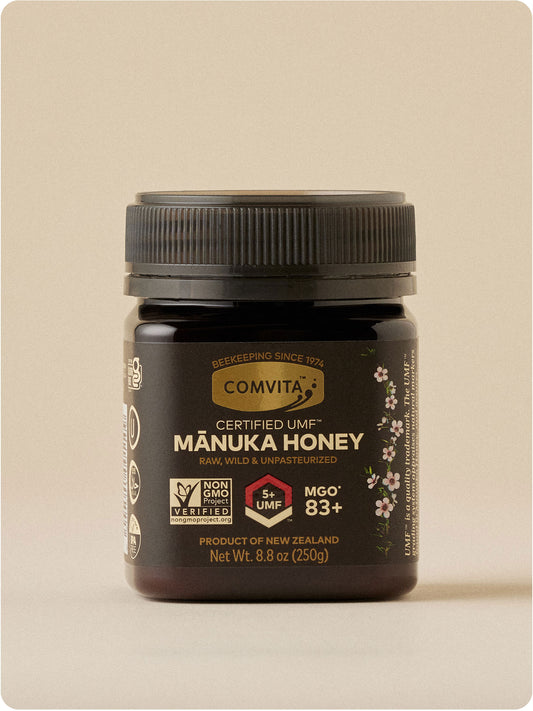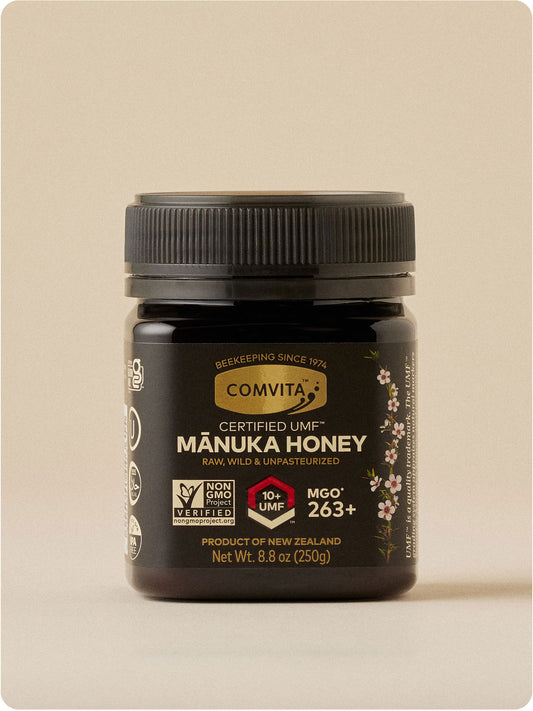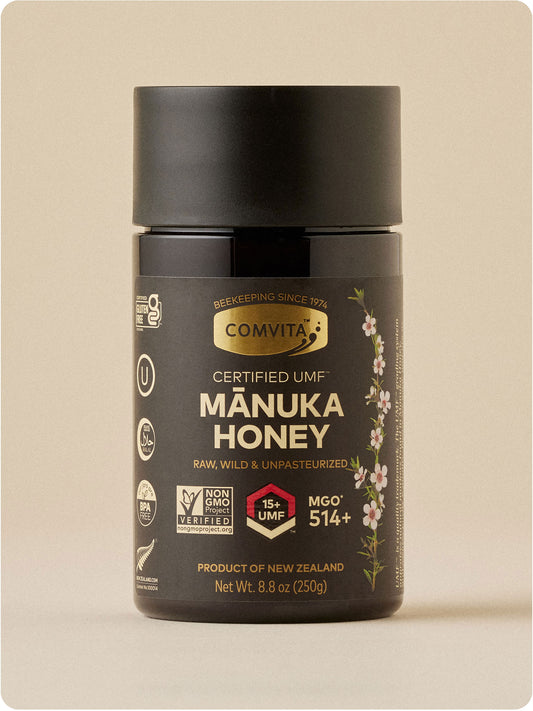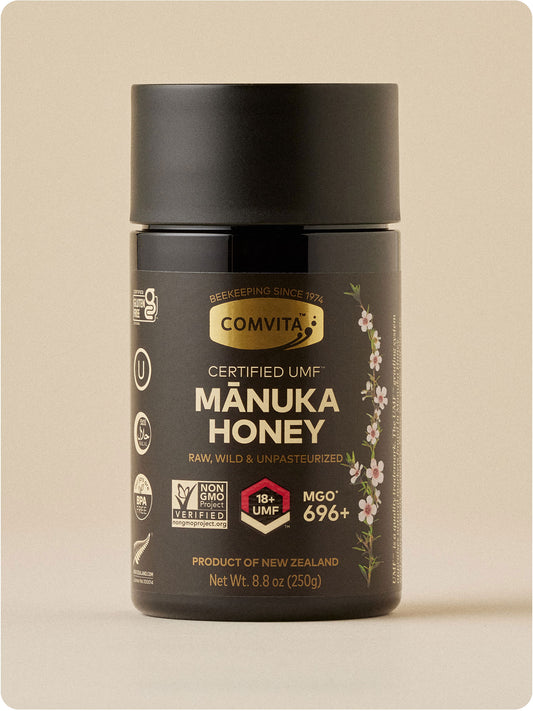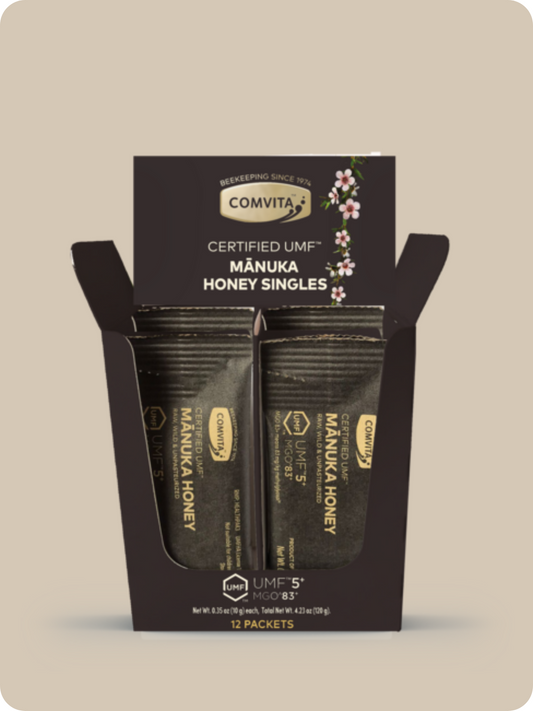
UMF™ - The Ultimate Rating System for Manuka Honey
What you need to look for when choosing and buying your honey.
There’s no other honey in the world like New Zealand Mānuka honey. Made by bees collecting nectar from the Mānuka plant (Leptospermum scoparium), genuine Mānuka Honey is one of nature’s rare and powerful wonders, renowned the world over for its beneficial properties.
So far so simple. But as you may have discovered, shopping for the best Mānuka Honey may not be quite so easy. With so many different grading systems and distinctions, you probably find yourself wondering, what do all those letters and numbers mean? Is there honestly a difference? (The answer is yes by the way!).
We’ve called on the expertise of Dr. Jackie Evans PhD, Chief Science Officer for Comvita to help explain. So keep reading to discover what are UMF™ and MGO ratings, what’s the difference and what matters when selecting the best and most authentic Mānuka Honey.
Manuka Honey grading systems
The rating system for Mānuka honey is rather complex and several different systems can be used, including UMF™ (Unique Mānuka Factor) and MGO (Methylglyoxal).
UMF™ is the strictest and highest graded Mānuka Honey measurement system. The UMF™ number on the label represents the amount of MGO in the bottle as well as providing a broader guarantee of authenticity, origin and composition. That number can range from UMF 5+ to UMF 20+. The higher the UMF™ rating, the more antibacterial activity Mānuka Honey has – and the more potent it is.
What is the MGO rating system
Methylglyoxal (MGO) is a naturally-occurring compound found in Manuka Honey that gives it its unique antibacterial potency.
The number that follows ‘MGO’ refers to the amount of methylglyoxal in mg/kg. For example, an
MGO250+ Mānuka honey product is certified to contain at least 250mg of methylglyoxal per kilogram of honey.
What is the UMF™ grading system?
UMF™ stands for Unique Manuka Factor, the only standardized industry-wide indicator of genuine Mānuka honey from New Zealand. It is a stamp of authority that authenticates the potency, purity, freshness and New Zealand origin of a Manuka Honey product.
The UMF™ mark is also a guarantee that the product meets the New Zealand government regulatory standard for Mānuka Honey, and that it contains the broad suite of phytochemicals that make Mānuka unique. MGO is only one component and therefore does not provide the same level of assurance as the UMF™ mark.
MGO vs UMF™ – Which is best?
The main difference between MGO and UMF™ is that MGO only measures the methylglyoxal element in Mānuka Honey and its potency. UMF™ on the other hand, measures three chemical compounds found in Mānuka Honey: dihydroxyacetone (DHA), leptosperin and methylglyoxal.
This means that measuring just MGO alone doesn’t give you sufficient assurance of the authenticity, purity and quality of the Mānuka Honey you’re buying. UMF™ is a broader and far more accurate indicator of authenticity purity and quality of honey.
How UMF™ measures the three signature compounds in Manuka honey
As we’ve seen, only the UMF™ testing process measures all three signature compounds, Leptosperin, DHA and Methylglyoxal (MGO), that together indicate high quality, authentic Mānuka Honey – while other systems measure only one or two. This process gives you a much more comprehensive and assured view of what’s in your honey.
While we can’t guarantee the accuracy of other measurement systems, this is an approximate MGO vs UMF conversion guide:
| Manuka Honey Type | Minimum MGO Rating | Minimum UMF Rating |
|---|---|---|
| UMF5+ | 83 | 5 |
| UMF10+ | 263 | 10 |
| UMF15+ | 514 | 15 |
| UMF18+ | 696 | 18 |
| UMF20+ | 829 | 20 |
What makes UMF™ Certified Mānuka Honey different from other honeys?
As we’ve learned, the UMF system is the gold standard for independent assurance of the origin, quality and potency of Mānuka Honey – and only the highest quality Manuka honey carries the UMF™ mark. The Unique Mānuka Factor (UMF™) system is an independently certified quality mark issued by the UMF™ Honey Association.
The UMF™ mark is only granted to genuine monofloral Mānuka Honey from New Zealand and it is the only grading standard where the governing organization carries out independent testing of its members’ honey once it reaches retail and online stores globally, thus guaranteeing its authenticity for consumers.
Comvita monofloral Mānuka Honey is certified with the UMF™ quality mark, which means you can be sure of the origin and quality of every jar of honey that bears our name.
The higher the UMF™ the better?
Comvita’s UMF strength ranges from 5+ to 20+. The higher the number, the higher the concentration of these beneficial compounds, which is why higher UMF level honey also tends to have a darker color and distinctive tangy, taste (some might call it ‘medicinal’).
The minimum level for monofloral Mānuka ( Mānuka Honey sourced from one plant) is 80, meaning our Manuka Honey UMF 20+ is significantly higher than this.
The renowned health properties of Mānuka Honey are believed to be more potent, concentrated and potentially more effective when the UMF number is higher - giving you an extra boost of goodness when you need it most.
About Dr. Jackie Evans
Dr. Jackie Evans, PhD is Chief Science Officer for Comvita. Prior to joining Comvita in 2017, she worked in global clinical development roles in the Pharmaceutical Industry in the United Kingdom, and in national pharmaceutical funding roles with the New Zealand Government. She has a First Class honors degree in Microbiology from the University of Reading and a PhD in Virology from University College London, where she studied HIV immunology.
At Comvita, she applies her science and clinical research background and skills to advance the science of Comvita’s products, working with the best researchers to deliver the highest quality products backed by science. She is a mom to two girls and lives in the beautiful Bay of Plenty in New Zealand.
Made by nature, proven by science
As the pioneer and global leader in crafting Mānuka Honey, Comvita has always been committed to purity, safety and authenticity. For over 46 years, we’ve cultivated a reputation that goes beyond our word and turns to the industry’s most rigorous and comprehensive independent standard: UMF™ Certification.
We test every single batch of our genuine Mānuka Honey to be sure it meets (and exceeds) all requirements and levels of active compounds to provide the purest, highest quality Mānuka Honey from New Zealand.
FAQs
Which is better UMF or MGO?
UMF is a complete, advanced grading system; thus, it is a purer indicator. However, MGO is simpler and more straightforward to test. Therefore, you cannot say one is more reliable than another.
Is higher MGO Mānuka Honey better?
Mānuka Honey comes in a range of MGO ratings. The higher the number on the label, the better the health benefits and anti-bacterial properties are.
What is the difference between UMF 15 and 20?
Low to mid grades of UMF 10+ to UMF 15+ are called Therapeutic Grade (good for short term consumption). Lower UMF ratings means less MGO, less MGO means less antibacterial benefits.
Generally, higher grade UMF 15+ or UMF 20+ Manuka Honeys are more effective at killing active bacterial infections. The higher the UMF rating, the more antibacterial activity the Mānuka honey has and the more potency of MGO (Methylglyoxal) it has.





